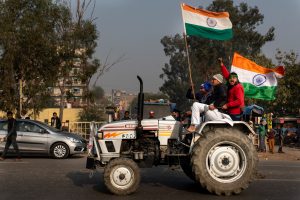Since November, thousands of farmers have encamped outside New Delhi, India protesting three farm laws enacted in the Monsoon Session of Parliament last year.
The contentious new agricultural laws would minimize the government’s role in agriculture and open more space for private investors. The government has claimed that the new laws will “unshackle” the farmers and private investment, bringing growth. The International Monetary Fund (IMF) has backed the move, adding that the new farm laws have the potential to represents a significant step forward for agriculture reforms in India.
The protesters, however, disagree. The farmers camped outside Delhi worry that allowing the private sector a larger role will eventually decimate small-scale farmers by lowering the price of agricultural products. For decades, the Indian government offered guaranteed prices to farmers for certain crops, providing long-term certainty to the farmers. However, the new farm laws allows farmers the freedom to fix their own prices for their crops and sell across state boundaries. Farmers worry this will eventually hollow out prices as a race to the bottom emerges. They demand that the laws be repealed and say they will accept nothing less.
So far, 11 rounds of talks between the farmers and the central government have failed to reach a consensus. The Supreme Court has suspended the implementation of the farm laws, and created a committee to ascertain the various grievances. Even as the agitating farmers welcome the stay on implementation by the apex court, they have rejected the committee, as it might paralyze all legal options for the movement if the committee’s recommendations leave them unsatisfied as well.
On January 26, as India celebrated its 72nd Republic Day – marking the day on which the Indian Constitution came into effect – thousands of protesting farmers participated in a tractor rally as a sign of protest. On the eve of the event, farm union leaders had announced that they would carry out a peaceful march with about 150,000 tractors. They added that more than 3,000 volunteers would be stationed at various points along the way to ensure that the farmers followed the routes negotiated with the Delhi police.
Although the parade was mostly peaceful and most farmers followed the guidelines of the farm union leaders, reports of violent clashes between the police and farmers soon surfaced as a fraction of farmers pushed aside barricades and made their way into the city and other sensitive areas – including the Red Fort, a 400-year-old palace that once served as the residence of the Mughal rulers in India. The clashes resulted in the death of at least one protestor and left nearly 300 police officers injured.
Farmers claim the violence was stoked by the government and outside elements in an effort to derail their months of peaceful protest, which was drawing international attention and support.
At the Ghazipur border – one of the spots where farmers camped and where these photographs were taken – tractors pushed aside a shipping container blocking their route, as police stood by.
Alina Tiphagne is an independent documentary photographer and visual journalist based in New Delhi, India. Her work focuses primarily on social issues, human rights and social movements by documenting the cerebral lives of her subjects. Her images have been published by Amnesty International India, The News Minute and Telepolis (Germany).











































